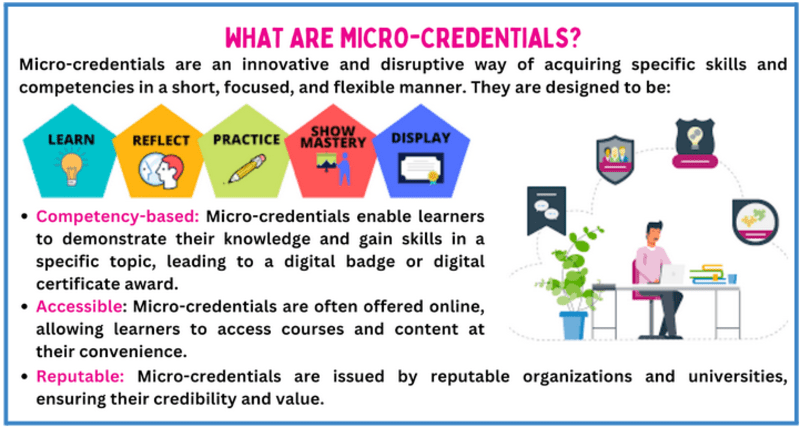Micro-credentials, the next chapter in higher education
Relevance: GS I and II (Social Issues and Justice)
- Prelims: National Education Policy 2020; National Credit Framework (NCrF);
- Mains: Infrastructure; Education; Higher education institutes (HEIs) in India; National Education Policy 2020;
Why in the News?
Higher education institutes in India can be the catalysts in integrating micro-credentials with existing academic programmes.
About:
- There is a gap between the knowledge that students acquire in HEIs and the knowledge they must have in order to become employable.
- Hence, the Higher education institutes (HEIs) in India must play a much more active role in ensuring that students become employable by connecting them with the careers and job opportunities of tomorrow.
- Micro-credentials are emerging as a disruptive way of bridging this gap to acquire ‘just-in-time’ modern skills and competencies.
The essence of micro-credentials:

How do micro-credentials work?
Micro-credentials are smaller courses of a larger achievement, skill, or topic, and they improve employability by:
- Enabling learners to gain knowledge fast: Micro-credentials are designed to be short and focused, allowing learners to acquire specific skills quickly. Courses are generally designed to be of three to four credits, and one credit corresponds to one hour of lecture or two hours of lab work per week.
- Helping professionals fill the gaps in their skillset: Micro-credentials can help professionals fill the gaps in their skillset, making them more competitive in the job market.
- Multiple players such as Atingi, Alison.com, Credly, Coursera, edX, FutureLearn, Google, Linkedin, Microsoft, PwC and Udacity offer micro-credentials.
- Many universities in Australia, Canada, Europe, the United Kingdom and the United States are also engaged in providing micro-credentials.
- Offering a cost-effective method of learning: Micro-credentials are often more affordable than traditional degree programs, making them accessible to a wider range of learners.
- Making learning accessible to busy lifestyles: Micro-credentials are designed to be flexible, allowing learners to study when it's convenient for them.
- In contrast to micro-credentials, students must study for several years to obtain macro-credentials such as undergraduate degrees.
- In addition, micro-credentials can also be designed for life-long learners, i.e., working professionals who may not be able to attend a formal degree programme in a university.
- Optionally stacking towards a complete qualification: Micro-credentials can be stacked to earn a complete qualification, such as a degree or certification.
- Combining to expand knowledge across a variety of topics: Micro-credentials can be combined to expand knowledge across a variety of topics, allowing learners to develop a diverse skill set.
Fostering Trust is a key step:
- To ensure genuine acquisition of skills: Micro-credentials must be aligned with higher education standards in the areas of delivery, assessment, grading and the awarding of qualifications. Capacity to devise reliable assessment methods is critical in fostering trust in micro-credentials, and in this task, the association of HEIs is of great importance.
- Opportunities in integrating diverse skills: Micro-credentials can open up opportunities in integrating diverse skills as a part of their regular education, or they can store the credits on the ABC platform for redemption later or to get a separate certificate or diploma in addition to their macro-credentials.
- Duration and learning outcomes: Micro-credentials can be given as between one to five credit short modules. Or, learners can accumulate multiple short modules to earn the total number of credits required to obtain a degree as specified in the NCrF.
|
Is there enough demand for micro-credentials in India?
|
Potential in India:
- India now has a National Credit Framework (NCrF), which spells out learning outcomes and corresponding credits a student should accumulate in order to progress to the next level of learning.
- One of the primary benefits of micro-credentials is that they are portable and stackable on a digital platform such as the Academic Bank of Credits (ABC).
- As the NCrF is being implemented across the country, it is the right time for Indian HEIs to plan to develop micro-credentials in partnership with industry.
- The NCrF offers an opportunity for HEIs to examine the development of credit-based micro-credentials as a part of regular degree programmes.
- Broader deliberations must take place on the potential impact of micro-credentials and the additional value they can create in the tertiary education system.
Conclusion:
Indian HEIs are encouraged to introduce micro-credentials as a vital element of their strategic institutional objectives and work towards harmonizing them with existing academic programs by developing clear validation metrics.
Mains PYQs
Q. The quality of higher education in India requires major improvement to make it internationally competitive. Do you think that the entry of foreign educational institutions would help improve the quality of technical and higher education in the country? Discuss. (2015)
Q. National Education Policy 2020 is in conformity with the Sustainable Development Goal-4 (2030). It intends to restructure and reorient the education system in India. Critically examine the statement. (2020)


